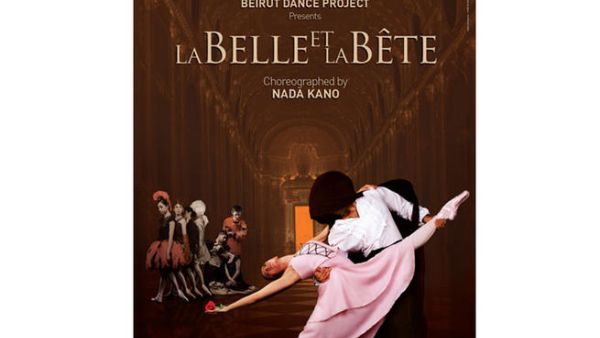Lebanese choreographer and dancer Nada Kano founded the Beirut Dance Studio in 2007. From these roots grew the Beirut Dance Project in 2009, the aim of which has been to help children from disadvantaged families achieve their dream of becoming dancers.
Over the last few years, Kano has choreographed a range of works. “The Dress” and “Un-re(a)lating” were popular hits and demonstrated Kano’s prominent place on the landscape of Lebanon’s contemporary dance scene. She spoke to The Daily Star about her new ballet “Beauty and the Beast,” which will be staged at Monnot Theater over the weekend.
Q: As you know, the story “Beauty and the Beast” is a pop culture commodity, having spawned a television series and a Disney cartoon. How closely does your show conform to this story? How did you come to this story?
A: It really is an adaptation. I just chose “Beauty and the Beast” because I thought it was a nice tale, something [with which] I wanted to experiment. I followed the central thread of the story but I allowed myself to include a few things.
Q: How does this work relate to your oeuvre – “The Dress” and “Un-re(a)lating,” for instance? Do you see it as a departure, or are there more continuities in the themes and the way you developed the work?
A: It has nothing to do with my previous works. [The Beirut Dance Studio and Beirut Dance Project] are two completely different structures from one another. Here, it is a project based on professional training. Two-thirds of the students are coming from disadvantaged areas in Beirut and have a scholarship.
It is a classical ballet. There [are] a few touches of neo-classical but it has nothing to do with what I do with the [BDS] company. We are really in workshop mode here. Most of the participants are teenagers.
Q: What is the reach of the Beirut Dance Project nowadays? How do you see the progress of the disadvantaged children to whom you are providing arts education? How many of them are part of the show?
A: The Beirut Dance Project is a project [focused on] professional training. The participants of this show want to be dancers. They work several hours per day, and nonstop on the weekends. It is a long-term involvement.
Their progress is huge. It is a group that has a lot of potential. Some student exchanges are expected in other countries. We are trying to get an international standing with this training.
There are 23 participants in the show. The two main characters [the Beauty and the Beast] are professionals from the company. They were dancing in “Un-re(a)lating.” The other [dancers] are in training. They have quite an advanced level.
Q: All the profits from this show will go to Beirut Dance Project. How’s the financial health of the BDP? What have your sources of finance been since founding BDP, and how has your project been affected by the financial crisis of 2008?
A: Originally, BDP has for aim to recruit children coming from disadvantaged areas who want to be dancers. It is not to dance just as a hobby. They would have never had the chance with this. The project started in 2009 and it was launched because we had contributions from UNESCO. But after that, we had a lot of difficulties. We are constantly searching for contributions. We had before financial help.
This show is a fundraising [event] because we came to a point where we cannot keep on going like this. It’s a shame. This is why we decided on [this event] to continue the training for these children and to recruit a new troupe.
We are starting from scratch to get to an international standing. It has never been done in Lebanon. There is no dance conservatory here, no professional training, there are no possibilities. It is a dead end. It is true that, for the Beirut Dance Studio, the dancers started really early, but they weren’t trained in such a rigorous way. Maybe they develop their contemporary dance language more rapidly than the others. But with the others, it is a more global training.
Q: How would you describe the choreography of the show? By what process do you usually develop your choreography?
A: I try some moves, I try to see where they are more at ease, where they can more [adequately] play the character. I cannot make someone dance if the role doesn’t go with his/her personality.
Q: What type of soundtrack did you choose? Is it an originally composition, or are you using prerecorded music?
A: [The soundtrack] is a puzzle of classical music. Some of [the excerpts] are a bit jazzy, others revisited. But we stayed more in the academic area here. I go step by step. I try to keep my grounds. Maybe a few years later they will be more mature and we will go into new possibilities.
Q: Nowadays the video screen and playback have become a major part of theater, dance and the performing arts generally. Are you in favor of incorporating video into your work, or do you think it just distracts the audience from the real center of attention – the dancers and the choreography? Will the new show have a video component?
A: It really depends on how it is done. Before we used to put decor on stage, maybe now it is [like this] due to technology. It depends. Actually, it can work as makeup.
We’ll project still images. It is just better than having a white background. But it doesn’t [have] any other role than this. It is more practical than building the [set design]. Especially that it is a fundraising [event], so we’re trying to save a bit of money.
As the usual in Lebanon, we cannot rehearse enough in theaters, this is why we’re trying to get to the more rapid solutions.
Nada Kano’s ballet “Beauty and the Beast” will be staged at Monnot Theater from Friday to Sunday. For more information, please call 01-202-422. All profits will benefit the Beirut Dance Project.








